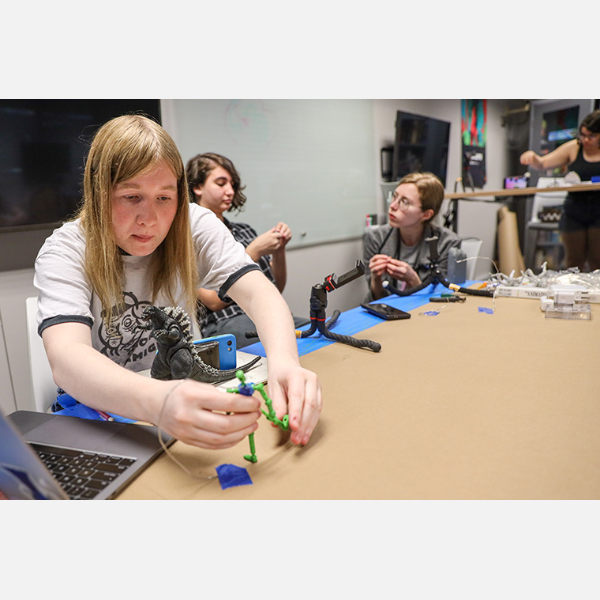Frame-by-Frame Fundamentals
Stop-motion animators, as with all animators, lean on the foundations – namely, the 12 basic principles of animation established by classic Disney animators and taught at Bradley. Without these foundations, animations would look limp and lifeless. The same is true of stop-motion puppets without the precision skeletons hidden inside that allow them to hold poses.
Brian Hahn, Head of Mechanical Fabrication at Laika Studios, designs these skeletons, known as armatures, for stop-motion feature films like “Paranorman and The Boxtrolls.” He recently came to Bradley to share some of the wisdom he’s picked up in the industry.
Surrounded by students molding clay as they recorded bouncy balls for reference, Hahn told them stop-motion is accessible. That’s his key takeaway for the students, after having witnessed far too many aspiring animators fall down the rabbit hole of overspending on expensive equipment.
“I’m purposely starting with the basics,” he said. “The first thing they animated was a sheet of paper. They’re also animating with simple aluminum wire, all to get them to a point where the fundamentals of animation are simple.”
The students also had the opportunity to view one of the puppets used to animate the title character in 2016’s “Kubo and the Two Strings.”
“Although I’m around these puppets all the time, seeing what the animators are able to do with them to make them look alive is just ridiculous,” Hahn said.
With the field of animation spanning such a wide range of mediums, from 2D to 3D to stop-motion and more, it’s of particular importance to build a strong foundation. Brent Wiley, assistant professor in the animation department, explained how at Bradley, students not only explore animation, but all the other levels of the animation pipeline as well. This includes pre-production, storyboarding, scripting, character design, modeling, texturing, shading and lighting, and rendering.
“We try to make them a one person band so if they want to self-direct something, they can,” Wiley said. “We know that in industry, realistically, there's a lot of specialized roles and specialization of labor. On larger scale projects, obviously you're going to work in a specific department, but for shorts, you have the freedom to work in a number of capacities and create your own little story.”
One such self-directed story stood out to Brian Hahn – a short called “The Siege of Castle Bradley” by senior animation major Lorenzo Burgos. In it, Burgos uses Lego bricks and stop-motion to showcase each of the twelve principles of animation. The short also features computer generated elements, blurring the boundaries between forms and adding a significant amount of impact to a wizard duel.
“For any kind of art form, you just have to be motivated and enjoy doing the work,” Hahn said. “This has to be something that you do for fun, and you don’t mind spending hours doing. And once it’s a passion, the work comes easy. Learning becomes easy.”
–Jenevieve Rowley-Davis







